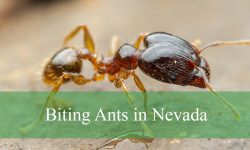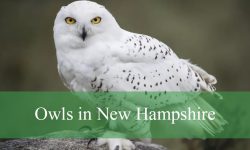Florida is home to several species of wrens, each with its own unique charm and behavior. From the bold, year-round Carolina Wren to the elusive migrants like the Marsh and Sedge Wrens, these small but energetic birds bring life and music to backyards, wetlands, and forests across the state. Their songs, habits, and adaptability make them fascinating to observe for both casual birdwatchers and dedicated enthusiasts.
While some wrens are common and easy to spot, others appear only in winter or as rare visitors, rewarding patient birders with memorable encounters. Learning how to identify each species by appearance, song, and preferred habitat is the key to fully appreciating these lively songbirds. This guide will introduce you to seven types of wrens found in Florida, along with tips on where and when to find them.
Common Wrens Found in Florida
Carolina Wren (Thryothorus ludovicianus)
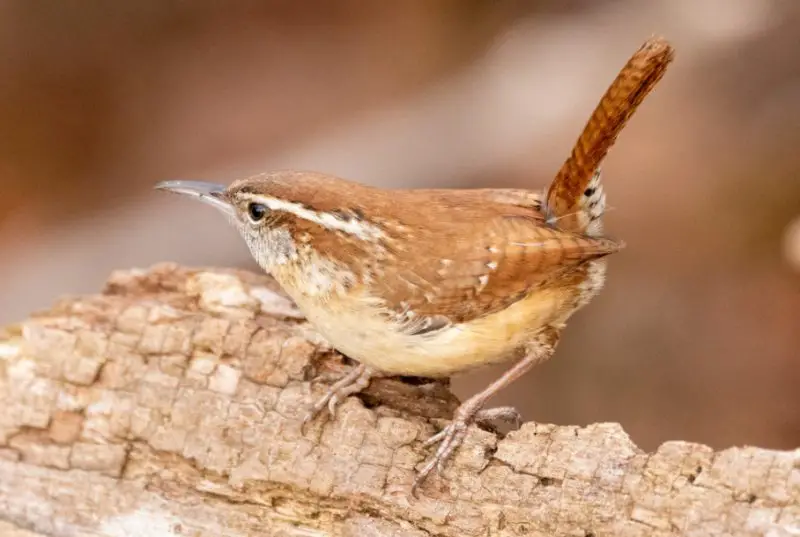
The Carolina Wren is the only wren species that resides in Florida year-round, making it a familiar sight in backyards, forests, and suburban areas across the state. It is a small yet robust bird, measuring around 4.7 to 5.5 inches in length with a wingspan of 11 inches. Its plumage is a rich reddish-brown above with a buffy-orange belly, complemented by a striking white eyebrow stripe that makes identification easier. This bold marking, paired with its slightly curved bill, helps birders recognize the species even from a distance.
Behaviorally, the Carolina Wren is known for its loud and musical “tea-kettle, tea-kettle, tea-kettle” song that can be heard throughout the year in Florida. Despite their small size, they sing with remarkable strength and will often sing in pairs, with the male leading and the female responding in softer tones. They are curious and active, flitting about in dense vegetation, underbrush, and even human structures like garages or sheds. Their fearless nature often brings them closer to human dwellings than many other wrens.
In terms of feeding habits, Carolina Wrens primarily consume insects, spiders, and other small invertebrates, though they will occasionally eat berries or seeds. They forage close to the ground, scratching through leaf litter and probing crevices with their curved bills. Their adaptability allows them to thrive in both natural and human-altered environments, making them one of the most successful wrens in Florida. Nesting occurs in spring, with pairs often reusing cavities, nest boxes, or even hanging flowerpots. The female builds a dome-shaped nest lined with soft materials, where she lays 3 to 7 eggs.
A fun fact about Carolina Wrens is their resourcefulness in choosing nesting sites; they have been found nesting in mailboxes, boots, and even pockets of hanging laundry. Their range extends across the entire state of Florida, from dense swamps to urban gardens, and their population remains stable thanks to their adaptability. They are truly a staple of Florida’s avian community and a favorite among backyard birdwatchers.
House Wren (Troglodytes aedon)
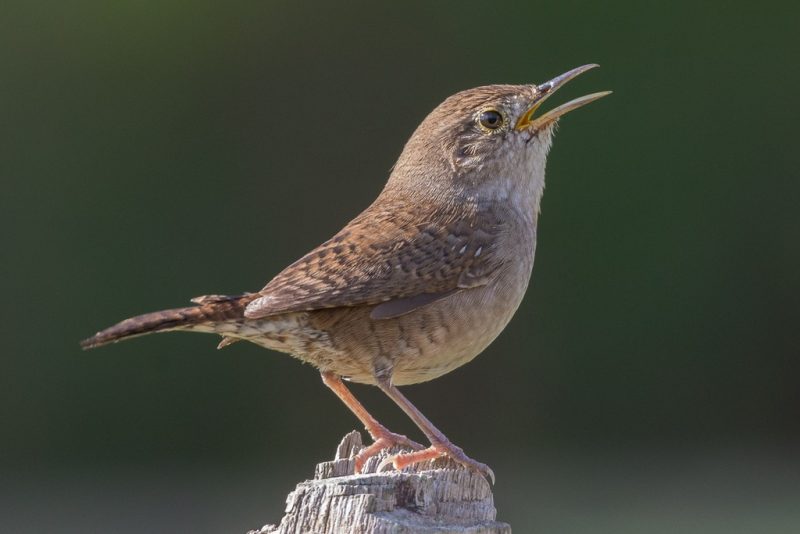
The House Wren is a seasonal visitor in Florida, most commonly appearing during the cooler months of winter and late spring migration. This small bird measures about 4.3 to 5.1 inches long, with a wingspan of 6 inches. Unlike the colorful Carolina Wren, the House Wren is drab brown overall with faint barring on the wings and tail, blending well with its surroundings. Its plain appearance can make identification tricky, but its constant tail flicking and bubbly, warbling song set it apart from other small brown birds.
House Wrens are highly energetic and spend much of their time darting through shrubs, tangles, and brush piles in search of food. They are insectivorous, feeding on beetles, caterpillars, spiders, and flies, which they capture by hopping through vegetation and probing bark crevices. During their stay in Florida, they are often seen in parks, wooded edges, and residential yards where nest boxes or natural cavities are available. Unlike many birds, House Wrens are very adaptable to human presence, frequently choosing man-made structures for nesting.
Breeding behavior is particularly fascinating with House Wrens. Although they do not breed in Florida as frequently as they do in northern states, males often arrive early to claim nesting sites by filling several cavities with twigs. The female then chooses one of these “dummy nests” to complete with softer materials like feathers and grass before laying 5 to 8 eggs. They are highly territorial, often destroying eggs of other birds that compete for cavity space, which has earned them a reputation for being aggressive neighbors.
A fun fact about House Wrens is that despite their small size, they are one of the most widely distributed songbirds in the Americas, ranging from Canada to the southern tip of South America. In Florida, they are most easily observed during the winter months in shrubby habitats and residential gardens. Their cheerful song and active nature make them a welcome sight to birdwatchers across the state.
Marsh Wren (Cistothorus palustris)
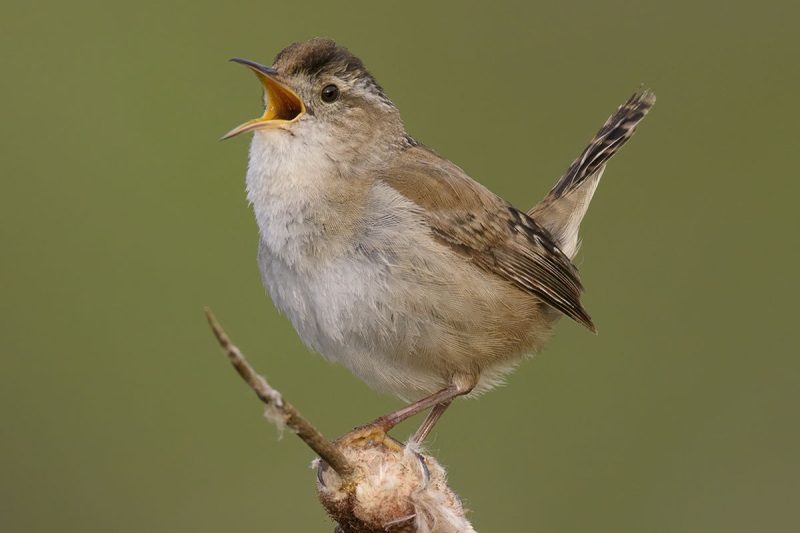
The Marsh Wren is a winter migrant to Florida, commonly found in freshwater and brackish marshes dominated by cattails, reeds, and tall grasses. This small bird, measuring 4.7 to 5.5 inches long with a wingspan of 7 inches, has a distinct appearance. It is dark brown above with black and white streaks on its back, a lighter belly, and a bold white eyebrow stripe that differentiates it from the smaller, streakier Sedge Wren. Its long, slightly decurved bill is perfectly adapted for probing reeds and grasses.
Marsh Wrens are highly secretive, often heard more than seen. They are famous for their loud, gurgling, and chattering songs that carry across marshes, especially during breeding season. While in Florida during the winter months, they are less vocal but still display energetic behavior, hopping through dense vegetation and occasionally perching on reed stalks. They are skilled climbers, using their strong legs and toes to grasp vertical stems while foraging for insects, spiders, and other small invertebrates.
Breeding for Marsh Wrens typically occurs outside Florida, but they still exhibit their unique nest-building habits while overwintering. Males construct multiple dome-shaped nests woven from grasses, many of which remain unused. This behavior is thought to deter predators or to demonstrate their strength to potential mates. Their true breeding territories lie further north, but Florida marshes provide critical winter refuge where food is abundant and temperatures are mild.
A fun fact about Marsh Wrens is their remarkable vocal repertoire, with some males capable of producing over 200 distinct song variations. In Florida, they are most often encountered in the northern and central marshlands, though they can appear in coastal areas as well. Their presence adds vitality to wetland habitats, making them a rewarding find for patient birdwatchers willing to scan the reeds carefully.
Sedge Wren (Cistothorus platensis)
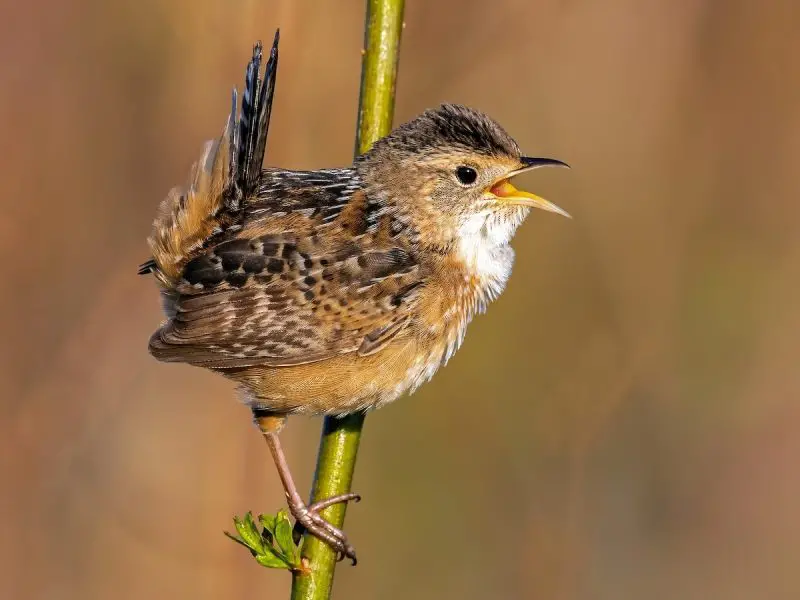
The Sedge Wren is another winter visitor to Florida, preferring wet sedge meadows, grassy marshes, and overgrown pastures. Slightly smaller than the Marsh Wren, it measures about 4 to 5 inches in length with a wingspan of 7 inches. Its plumage is pale brown with heavy streaking on the back and crown, a buffy belly, and a faint, less-defined eyebrow stripe compared to the Marsh Wren. These subtle field marks, combined with its quick movements, make it a challenging species to identify.
Unlike the Marsh Wren, the Sedge Wren is quieter and more elusive during its stay in Florida. Its song is a sharp, repetitive “chap-chap-chap” given mostly in breeding grounds farther north, so birders may not hear it as often in the Sunshine State. Instead, Sedge Wrens spend their time foraging low in dense grasses, where they feed on insects, spiders, and other small invertebrates. Their behavior is secretive, often moving like little shadows through sedges and reeds, rarely exposing themselves for long.
Breeding typically occurs outside Florida, especially in the northern United States and Canada, where males build multiple spherical nests hidden in tall grasses. The female selects one nest, lines it with softer materials, and lays 4 to 8 eggs. In Florida, Sedge Wrens do not breed but use the state’s marshes as important wintering grounds. Their presence is seasonal, with numbers peaking between October and April before they migrate back north.
A fun fact about Sedge Wrens is their nomadic tendencies; unlike many birds with fixed territories, they may change breeding sites from year to year depending on habitat conditions. In Florida, they are found in grassy wetlands scattered throughout the state, though they are less common and harder to spot than Marsh Wrens. Their cryptic plumage and secretive habits make them a special discovery for dedicated birdwatchers exploring Florida’s marshlands.
Winter Wren (Troglodytes hyemalis)
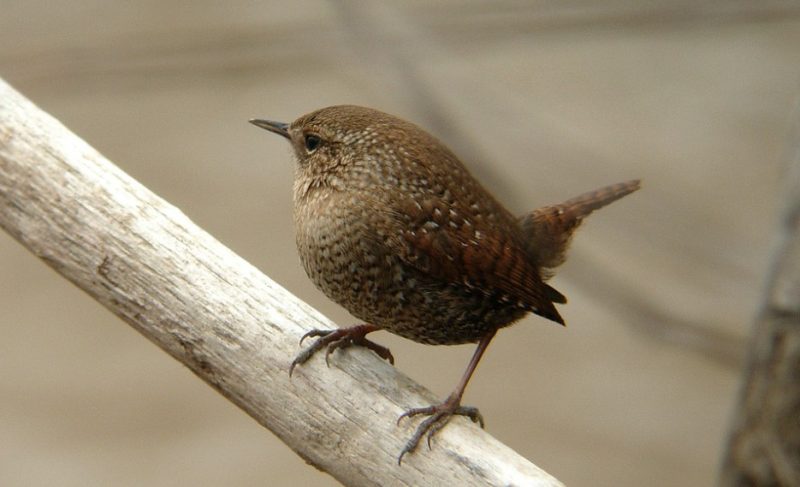
The Winter Wren is a rare and elusive visitor in Florida, with most sightings occurring in the northern regions of the state during the colder months. It is one of the smallest wrens in North America, measuring only 3 to 4 inches in length with a wingspan of about 6 inches. Its compact, round body, short tail usually held upright, and dark brown plumage with fine barring across the wings and flanks make it easy to distinguish once spotted. Unlike other wrens, its subtle colors help it blend seamlessly into the dense undergrowth of forests and thickets.
In terms of behavior, the Winter Wren is remarkably active and agile. It spends much of its time close to the ground, darting among fallen logs, brush piles, and root tangles where it hunts for insects, spiders, and larvae. Despite its tiny size, the Winter Wren is known for producing an astonishingly long and complex song, often lasting up to ten seconds and filled with rapid trills and high-pitched notes. However, in Florida, it tends to be quieter, focusing more on foraging than singing.
Although it does not breed in Florida, this species builds dome-shaped nests in northern regions, often tucked away in cavities, upturned roots, or mossy logs. The female lays 5 to 7 eggs and takes sole responsibility for incubation, while both parents feed the young after hatching. Florida serves as a winter refuge where the Winter Wren can find food and shelter in wooded ravines, swamp forests, and moist, shaded habitats that mimic its northern breeding grounds.
A fun fact about the Winter Wren is that, relative to its size, it sings one of the longest and most complex songs of any bird in North America. In Florida, spotting one is a true treat for birders, as their presence is fleeting and often limited to the northernmost counties. Their rarity in the state makes every encounter memorable and rewarding.
Bewick’s Wren (Thryomanes bewickii)
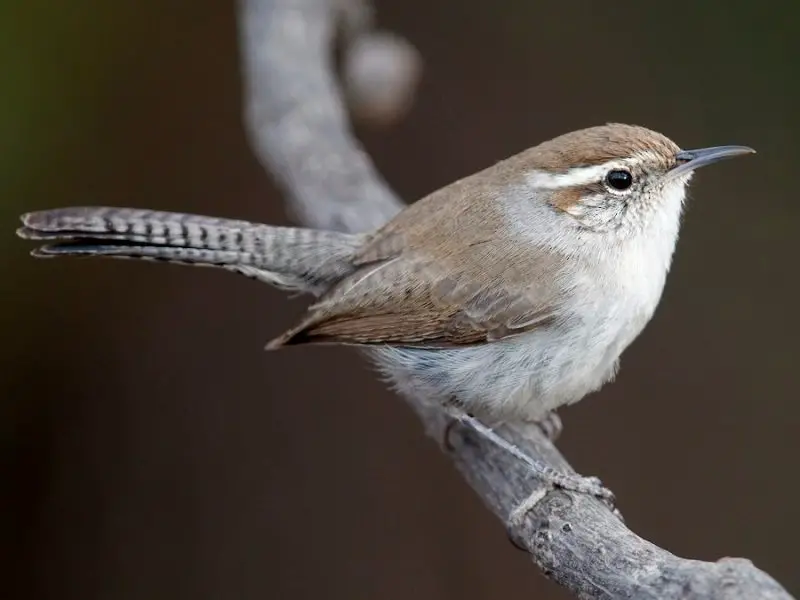
The Bewick’s Wren is a rare and localized species in Florida, with very few confirmed records throughout the state. This medium-sized wren measures about 5 inches in length with a wingspan of 7 inches. Its distinguishing features include a long white eyebrow stripe, grayish-brown upperparts, and a long tail often cocked and flicked sideways. Compared to other wrens, its tail is noticeably longer, which is one of the key field marks for identification.
Behaviorally, the Bewick’s Wren is inquisitive and agile, often moving quickly through brush, scrubby habitats, and thickets as it searches for food. Its diet consists mainly of insects, spiders, and caterpillars, which it gleans from bark crevices, low shrubs, and grassy areas. While foraging, it constantly flicks its long tail from side to side, a behavior that makes it stand out from similar wren species. In states where it breeds, the male sings a loud and musical song to attract a mate, but in Florida, its rare presence means birders are unlikely to hear its song.
This species typically breeds in drier habitats, where the female constructs a cup-shaped nest in cavities, nest boxes, or sheltered ledges. In Florida, it does not establish breeding populations, and observations are usually of individual birds straying from their normal range. Its stronghold lies farther west, and its decline in the eastern United States has contributed to its rarity in Florida.
A fun fact about the Bewick’s Wren is that it was once common in the eastern U.S., but habitat changes and competition with the House Wren have led to sharp declines in many regions. In Florida, it remains an occasional but exciting find, with sightings typically reported by dedicated birdwatchers and ornithologists.
Rock Wren (Salpinctes obsoletus)

The Rock Wren is considered an extremely rare species in Florida, with only a handful of historical records across the state. Native to arid and rocky environments of the western United States, this wren is out of place in Florida’s humid and flat landscapes, making every observation a remarkable event. It measures about 5.5 to 6 inches long with a wingspan of 9 inches, and its plumage is pale grayish-brown with fine speckling and a lighter belly. Its long, slightly decurved bill and habit of bobbing up and down are reliable identification clues.
In behavior, Rock Wrens are ground-dwelling birds that thrive in open, rocky habitats where they forage for insects, spiders, and other small invertebrates. They often hop across stones and ledges while probing cracks with their slender bills. When spotted in Florida, they typically appear in unusual locations such as coastal jetties, rocky outcrops, or man-made structures that mimic their preferred habitat. Their presence is usually temporary, as they do not find Florida’s environment suitable for long-term survival.
Breeding for Rock Wrens occurs in the western United States and parts of Mexico, where they build nests in rock crevices lined with small stones, shells, and feathers. This distinctive use of stones as part of the nest structure is unique among wrens and helps protect the nest entrance. In Florida, no breeding records exist, as their appearances are limited to wandering individuals far from their usual range.
A fun fact about Rock Wrens is their unusual nesting habit of lining the entrance to their nest with a trail of small rocks. This behavior, along with their preference for rocky terrain, sets them apart from other wrens. In Florida, seeing one is an extraordinary event, reserved for the most fortunate birdwatchers who happen to be in the right place at the right time.
FAQs about Wrens in Florida
Are Carolina Wrens found throughout Florida year-round?
Yes, the Carolina Wren is the only wren species that lives in Florida year-round. It can be seen in backyards, forests, swamps, and suburban areas across the entire state, making it the most common and familiar wren in Florida.
Do House Wrens breed in Florida?
House Wrens are mostly winter visitors in Florida and typically do not breed in the state. Instead, they nest farther north during the spring and summer. In Florida, they are often seen foraging in shrubs and using birdhouses or natural cavities for temporary shelter.
Where is the best place to spot a Marsh Wren in Florida?
Marsh Wrens are best spotted in freshwater and brackish marshes filled with cattails and reeds. They are secretive but can often be heard chattering and singing during the winter months in northern and central Florida wetlands.
How can I tell the difference between a Marsh Wren and a Sedge Wren?
The Marsh Wren has a bold white eyebrow stripe and darker streaks on its back, while the Sedge Wren appears paler with a less distinct eyebrow stripe and heavier streaking overall. The Sedge Wren is also quieter in Florida, whereas the Marsh Wren often sings loudly even in winter.
Are Winter Wrens common in Florida?
No, Winter Wrens are rare in Florida and are usually found only in the northern part of the state during the colder months. They are secretive, staying low in dense vegetation, and are more often heard in northern breeding grounds than in Florida.
Why are Bewick’s Wrens so rare in Florida?
Bewick’s Wrens were once common in the eastern United States, but their population has declined drastically due to habitat loss and competition with House Wrens. As a result, sightings in Florida are now extremely rare and limited to a few scattered records.
Has the Rock Wren ever bred in Florida?
No, the Rock Wren has never been known to breed in Florida. This species prefers rocky habitats in the western United States, and its appearances in Florida are considered accidental, with only a few historical records documented.
What do wrens eat in Florida?
Most wrens in Florida feed on insects, spiders, caterpillars, and other small invertebrates. Some species, such as the Carolina Wren, may also eat berries and seeds, especially in winter when insect prey is less available.
When is the best time to see wrens in Florida?
The best time to see wrens in Florida is during the winter months, from late fall through early spring. Carolina Wrens can be seen year-round, while species like House Wrens, Marsh Wrens, and Sedge Wrens migrate into the state during colder seasons.
Which wren species is the easiest to spot in Florida?
The Carolina Wren is by far the easiest to spot, as it is abundant across the state and often sings loudly even in residential areas. Other wrens, like Marsh Wrens and Sedge Wrens, require more effort to find in wetland habitats, while species such as Winter Wren, Bewick’s Wren, and Rock Wren are rare and much harder to encounter.



